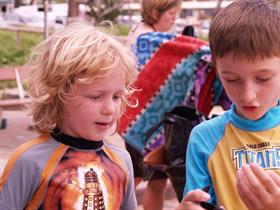Language Development
HOW DOES LANGUAGE DEVELOP
A child’s language and speech development is obviously an important part of their social and intellectual development. Here we will consider it as part of the cognitive development process, but recognise that it is part of other aspects of development.
From 0 to 18 months, a baby can go from making eye contact and crying to saying their first words. During the first 18 months of a baby’s life, the speech milestones are divided into two stages – "pre-intentional" and "intentional."
Pre-intentional usually occurs from 0 to 8 months. Here, the child does not have the cognitive skills necessary to create ideas in their minds and then act on them by planned actions, so they do not intend to communicate. From 0 to 2 months a child will develop different cries to mean different things – “My nappy is wet,” “I’m hungry,” etc. They may begin to make utterances that sound like vowels. From 2 to 4 months, they will gradually cry less. They make utterances that sound like consonants, such as "K." They may begin to make pleasure sounds such as "Mmm" and also make noises like “Coo” and “Goo.”
From 4 to 6 months, they begin to laugh. They may also do things like smacking their lips and blowing raspberries. They may use more vowel and consonant sounds. They begin to experiment with the pitch and sound of their voice when playing alone. From 6–8 months, they begin to babble in a repetitive way e.g. "Mama," or "Dada."
From 9 to 18 months, the child’s communication is intentional but not necessarily conventional. The child will "intend" to communicate. They may pick up an object and use it in the correct way. They may say sounds and words on purpose as they have a meaning.
From 8 to 10 months, the child will begin to make exclamations, such as “Ooh”. They will also make single consonant and vowel sounds such as "Bee," "Ma," "Go," etc.
From 10 to 12 months, the child may say their first word. They will also start to use proto-words, such as "Dmm" to mean 'dummy.' They are not real words, but the child will use them consistently to mean the same thing. The child will also begin non-repetitive babbling, such as "Goo goo da goo."
The child will start to use phrases from 12 to 14 months, such as “All gone” or “Ta ta.” The child will also start to talk very fast at around 12 to 15 months, but it will come as gibberish and not understandable.
From 14 to 16 months, children will express more gibberish, peaking usually at 18 months. At 18 months of age, the child will also begin echolalia, where the child repeats all or part of what a person has just said.
At 24 to 36 months a child can usually say all vowel sounds. They may be fairly understandable, particularly to their primary caregiver. They may make simple sentences.
At 36 months, a child can say 18 different consonants. The echolalia has usually gone and the child can usually talk more clearly.
At 36 months, the child is 75% intelligible, they may also use sounds such as "h, m, b, p."
At 4 years, usually the child is 100% intelligible and will make sounds correctly, such as "g, y, ng," etc.
From 4 years onwards, the child’s language will grow and develop, and the more they are encouraged their vocabulary will increase.
Between 4 and 5 years of age, a child will use around 1500 words and understand more. They will understand connecting words such as 'when' and 'but' and will also know words to describe emotions, such as 'upset.' They will begin to use more complicated sentences. A child of this age will be more easily understood, but may occasionally mispronounce complicated words. They will be better at taking turns in conversations and may tease and tell jokes.

From the ages of 7 to 9, a child should be speaking clearly and easily. They should be able to express a range of ideas and describe complicated events. They should be confident in using the phone by eight and able to talk in different tenses – past, present and future. They should also know how to tell jokes and enjoy reading on their own.
Throughout, levels of competencies that children will reach throughout their development have been described. As mentioned in the beginning, however, not all children develop in the same way at the same rate, so the guidelines are approximate descriptions and there will be variations between children.
This is an extract from the ebook "How Children Think" written by the Psychology faculty from our school. See this and other ebooks in our bookshop at www.acsebook.com
[21/04/2024 01:19:29]